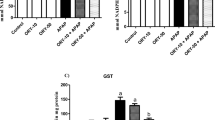Abstract
In the present study, we aimed to investigate the hepatoprotective and antioxidant potential of ferulic acid against acetaminophen-induced liver damage in mice. Hepatotoxicity was induced in mice by single dose of acetaminophen (900 mg/kg body weight i.p.). Ferulic acid (80 mg/kg body weight i.p.) and silymarin (25 mg/kg/body weight i.p.) were administered 30 min after the injection of acetaminophen. After 4 h, the mice were killed; liver markers (aspartate transaminase, alanine transaminase, alkaline phosphatase, and total bilirubin) were estimated in serum, while the lipid peroxidation and antioxidant status (superoxide dismutase, catalase, glutathione peroxidase, glutathione reductase, glutathione-S-transferase, and glutathione) were determined in liver homogenate. Liver markers (aspartate transaminase, alanine transaminase, alkaline phosphatase, and total bilirubin) and lipid peroxidation levels were found to be increased in mice exposed to acetaminophen, whereas the antioxidant status was found to be depleted compared to that of the control group. However, ferulic acid administration (80 mg/kg body weight i.p.) to acetaminophen-intoxicated mice significantly reverse (p < 0.05) the above-mentioned changes similar to the positive drug silymarin as evidenced in liver histology. The results clearly exhibit that ferulic acid possesses promising hepatoprotective potential.


Similar content being viewed by others
References
Baskaran N, Manoharan S, Balakrishnan S, Pugalendhi P (2010) Chemopreventive potential of ferulic acid in 7,12-dimethylbenz[a]anthracene-induced mammary carcinogenesis in Sprague–Dawley rats. Eur J Pharmacol 637:22–29
Bellomo G, Mirabelli F, DiMonte D, Richelmi P, Thor H, Orrenius C, Orrenius S (1987) Formation and reduction of glutathione-mixed disulfides during oxidative stress: a study with isolated hepatocytes and menadione (2-methyl-1,4-naphthoquinone). Biochem Pharmacol 36:1313–1320
Comporti M (1985) Lipid peroxidation and cellular damage in toxic liver injury. Lab Invest 53:599–603
Ghosh A, Sil PC (2009) Protection of acetaminophen induced mitochondrial dysfunctions and hepatic necrosis via Akt-NF-kappaB pathway: role of a novel plant protein. Chem Biol Interact 177:96–106
Habig WH, Pabst MJ, Jakoby WB (1974) Glutathione-S-transferases. The first enzymatic step in mercapturic acid formation. J Biol Chem 249:7130–7139
Jaeschke H, Knight TR, Bajt ML (2006) The role of oxidative stress and reactive nitrogen species in acetaminophen hepatotoxicity. Toxicol Lett 144:279–288
Janbaza KH, Saeedb SA, Gilani AH (2002) Protective effect of rutin on paracetamol- and CCl4-induced hepatotoxicity in rodents. Fitoterapia 73:557–56
Ju HS, Li XJ, Zhao BL, Hou JW, Han ZW, Xin WJ (1990) Scavenging effects of sodium ferulate and 18b-glycyrrhetic acid on oxygen free radical. Acta Pharmacol Sin 11:466–470
Lauterburg BH, Velez ME (1988) Glutathione deficiency in alcoholics: risk factor for paracetamol hepatotoxicity. Gut 29:1153–1157
Lieberta JJ, Matławskab I, Bylkab W, Murias M (2005) Protective effect of Aquilegia vulgaris (L.) on APAP-induced oxidative stress in rats. J Ethnopharmacol 97:351–358
Lowry OH, Roserrough NJ, Lewisfarr A, Randall RJ (1951) Protein measurement with the folin phenol reagent. J Biol Chem 193:265–275
Marklund SL, Marklund G (1974) Involvement of superoxide anion radical in the autoxidation of pyrogallol and a convenient assay for superoxide dismutase. Eur J Biochem 47:469–474
Moron MS, Depierre JW, Mannervik B (1979) Levels of glutathione. Glutathione reductase and glutathione-S-transferase activities in rat lung and liver. Biochem Biophys Acta 582:67–78
Murugesh K, Yeligar VC, Maiti BC, Maity TK (2005) Hepatoprotective and antioxidant role of Berberis tinctoria Lesch leaves on paracetamol induced hepatic damage in rats. Iranian J Pharmacol Ther 4:64–69
Ohkawa H, Ohishi N, Yagi K (1978) Assay for lipid peroxides in animal tissues by thiobarbituric acid reaction. Anal Biochem 95:351–358
Pan HZ, Zhao CY, Xu LN (1985) The effect on sodium ferulate on lipid peroxidation of erythrocyte membrane. Zhongguo Zhong Xi Yi Jie He Za Zhi. 678–680
Parmar DV, Ahmed G, Khandkar MA, Katyare SS (1995) Mitochondrial ATPase: a target for paracetamol-induced hepatotoxicity. Eur J Pharmacol 293:225–229
Rasool M, Sabina EP, Lavanya K, Nithya P (2007) Therapeutic effect of Indian ayurvedic herbal formulation Triphala on paracetamol-induced hepatotoxicity in mice. J Pharmacol Toxicol 2(8):725–731
Rotruck JT, Pope AL, Ganther HE, Swanson AB, Hafeman DG, Hoekstra WG (1973) Selenium, biochemical role as a component of glutathione peroxidase purification and assay. Science 179:88–590
Sallie R, Tredger JM, Williams R (1991) Drugs and the liver. Biopharm Drug Dispos 12:251–259
Sener G, Omurtag GZ, Sehirli O, Tozan A, Yuksel M, Ercan F, Gedik N (2006) Protective effects of Ginkgo biloba against acetaminophen-induced toxicity in mice. Mol Cell Biochem 283:39–45
Sinha AK (1972) Colorimetric assay of catalase. Anal Biochem 47:389–394
Solanki YB, Jain SM (2011) Hepatoprotective effect of Clitoria terenatea and Vigno mungo against acetaminophen and carbon tetrachloride-induced hepatotoxicity in rats. J Pharmacol Toxicol 6:30–48
Song Z, Craig J, McClain Chen T (2004) S-adenosylmethionine protects against acetaminophen-induced hepatotoxicity in mice. Pharmacol 71:199–208
Thampi HBS, Manoj G, Leelamma S (1991) Menon VP (1991) Dietary fiber and lipid peroxidation: effect of dietary fiber on levels of lipids and lipid peroxides in high fat diet. Indian J Exp Biol 29:563–567
Wallace JL (2004) Paracetamol hepatotoxicity: NO to the rescue. Br J Pharmacol 143:431–432
Yin ZZ, Wang JP, Xu LN (1986) Effect of sodium ferulate on malondialdehyde production from the platelets of rats. Acta Pharmacol Sin 7:336–339
Zhao Z, Moghadasian MH (2008) Chemistry, natural sources, dietary intake and pharmacokinetic properties of ferulic acid: a review. Food Chem 109:691–702
Conflict of interest
The authors declare that there is no conflict of interest.
Author information
Authors and Affiliations
Corresponding author
Rights and permissions
About this article
Cite this article
Krishnan, D.N., Prasanna, N., Sabina, E.P. et al. Hepatoprotective and antioxidant potential of ferulic acid against acetaminophen-induced liver damage in mice. Comp Clin Pathol 22, 1177–1181 (2013). https://doi.org/10.1007/s00580-012-1546-y
Received:
Accepted:
Published:
Issue Date:
DOI: https://doi.org/10.1007/s00580-012-1546-y



